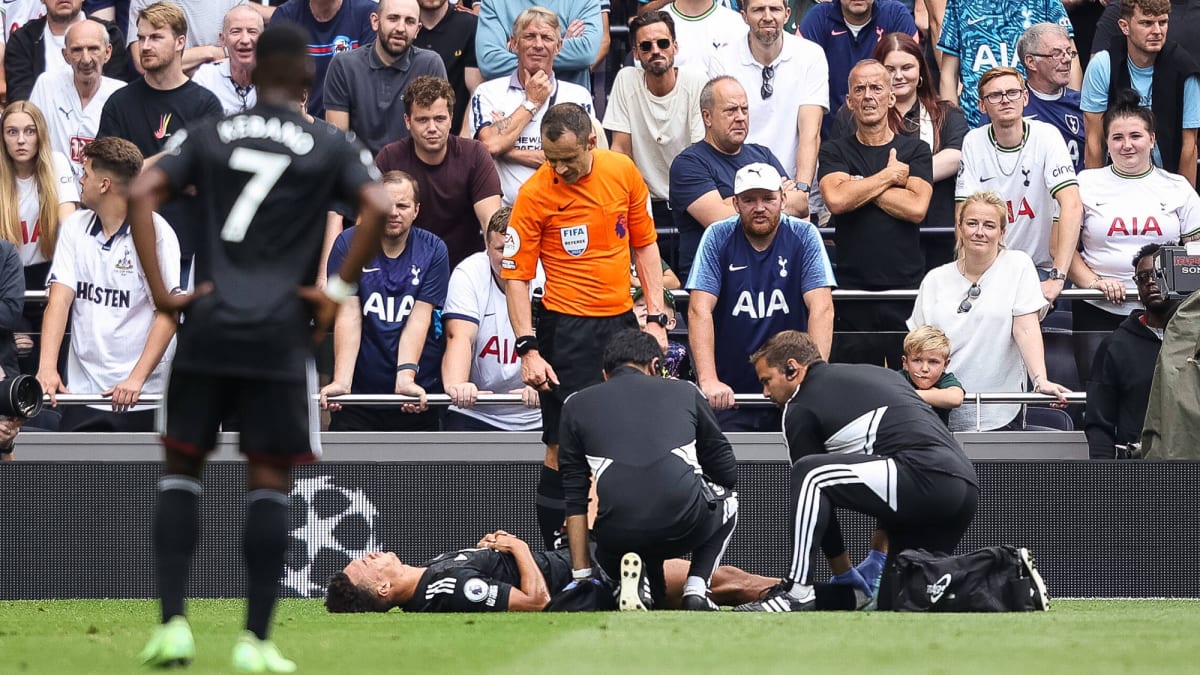Robinson may not be the most decorated U.S. player, but the left back is one of the national team’s most integral pieces, putting a spotlight on the status of his ankle.
Just over seven months ago, it appeared, for a brief moment, that Antonee Robinson was hurt. He had just scored a massive World Cup qualifying goal for the U.S. and celebrated with his trademark backflip only to pull up lame. Or at least feign pulling up lame. The whole thing was a gag, and a hilarious one at that. It’s since become something of a trend. But there was nothing comedic about the very real injury Robinson suffered Saturday playing for Fulham, and the left back’s right ankle suddenly becomes the most watched extremity in the U.S. player pool with the national team’s World Cup opener exactly 11 weeks away.
While there has been ample depth cultivated at most positions, the U.S. is quite barren behind Robinson when it comes to reliable options at left back, and when he rolled his ankle while planting to receive a pass and attempt a cross early in the first half vs. Tottenham, the prevailing takeaway was that of utter concern over what it might mean for the immediate future. It was the same reaction as on that January night in Ohio—only this time with actual substance to it.
Robinson, 25, has emerged as the emphatic answer to the U.S.’s long-running question at his position, and his injury and the specter of any kind of significant layoff reveals the fragility that can come with building a squad. Without proper cover or depth, all it takes is one freak instant to change a player and team’s outlook.
Sergiño Dest can feature at left back, but he’s more effective on the right and you risk altering the impact of two positions by having him flip sides. As a result, with the U.S.’s last pre-World Cup camp commencing in two weeks, the door could swing wide open for the likes of Joe Scally (Borussia Mönchengladbach, another who prefers to be on the right) or Sam Vines (Antwerp) if Robinson’s prognosis turns out to entail a long-term sideline stint. Until that is known, all he, Fulham and the U.S. can do is hope—and that’s the tone of his and his club manager’s comments in light of the injury.
“We’ll have to wait until tomorrow to see, and then day by day to see how he is,“ Fulham manager Marco Silva said in his postmatch press conference. “Let’s hope that it’s nothing serious and let’s hope he can be ready for next week, but now is too soon to talk about it.“
Fulham, which just signed France international left back Layvin Kurzawa on loan from PSG, should have ample cover at the position should Robinson’s injury be of the more serious variety. For the U.S., it wouldn’t be as straightforward.
Elsewhere in the most notable happenings for USMNT players abroad over the weekend:
Dest was given a glorious welcome at the San Siro upon his arrival at AC Milan on loan from Barcelona.
He did not feature in his side’s riveting 3–2 derby win over Inter, which should come as no surprise given he had just completed his move, but the onus will be on him to get on the field as soon as possible given how far behind his inactive period at Barcelona has made him. Outside of friendlies and preseason matches, Dest’s last competitive appearance for club or country came in last season’s finale for Barça, on April 24. That’s a period of over four months, and given his importance to the U.S.—whether on the left or on the right—it’s imperative that he develop some rhythm as the World Cup beckons. His move, however, appears to sit just fine with U.S. manager Gregg Berhalter.
“To go from Barcelona to AC Milan is not bad, right?” Berhalter told reporters last week in New York at an event celebrating Nike’s World Cup apparel launch. “Serie A is a competitive league. You got to defend really well in the Serie A, and it’s going to help him.”
Dest was deemed expendable by Barcelona manager Xavi, who had not minced words about the U.S. fullback’s outlook at Camp Nou. So he trades one iconic club and stadium for another, with hopes of it providing the spark that makes him World Cup-ready.
“It’s not nice when you’re told that you don’t have a spot in the group,” Berhalter said. “And Sergiño is a guy that I know believes in himself and believes that he could keep fighting through it. But I guess this opportunity came up that he thought was good for him.”
One player who did not get a move to a new environment is Christian Pulisic, but he did do something Saturday that he had yet to do this season: start a match. Pulisic played a promising if not unspectacular hour for Chelsea in what wound up being a wild 2–1 win over West Ham. And while he didn’t factor in the scoring, the extended minutes should at least temporarily calm some of the angst surrounding his club situation. For Berhalter, this pattern is nothing new.
“I’m a guy that bets on Christian just because I’ve seen it before,” Berhalter said last week, before the transfer window shut. “He is not counted on in a way that he’d like to [be], and he gets on the field and he proves everyone wrong and he ends up playing. I mean that’s what he’s been doing. So I tend to believe that’s going to happen. And I think his mind is in a good spot and I think he’s going to fight for it because that’s the type of guy he is.”
After speaking about this player pool last week, Berhalter was on the go this weekend, attending Celtic-Rangers at Celtic Park to see three potential U.S. call-ups live (Rangers’s Malik Tillman and James Sands, Celtic’s Cameron Carter-Vickers) and then Valencia-Getafe at La Mestalla to witness a midfield masterclass by Yunus Musah. The 19-year-old’s two assists helped spark a 5–1 win, and his first one, in particular, offered a display of class and an example of the end product that the U.S. has hoped to coax more regularly out of the talented prospect.
It came just days after Musah had a long-range rocket taken off the board by VAR, and he appears to be a player buoyed by a strong dose of confidence as a presumed trip to Qatar nears.
Another player in a similar boat is Josh Sargent, who scored yet again for Norwich, and assisted on another goal. The forward’s fifth goal in five games was that of a player who is hunting for goals and has become locked in on scoring them (albeit from a wing position and not in the center, where had been featuring recently), and with each one, it becomes more and more apparent that he’ll be back in the U.S. picture later this month after being out in the cold for so long.
His ascent, among others, has made Berhalter’s job a bit more tricky in the most desirable way.
“You hope that [U.S. forwards] keep scoring and you hope that they make it difficult for us as a staff,” Berhalter said. “You certainly would rather pick from guys that are scoring than guys that aren’t scoring.
“I’m not going to going to sugarcoat it. I think it does make it more difficult—doesn’t make it impossible, though. If you have four guys that have been in and are scoring and he’s the fifth who hasn’t been in and is scoring, it makes it more difficult.”
One of those players who had been scoring with regularity, Jordan Pefok, missed the chance to perform on a big stage, as he was held out of Union Berlin’s draw vs. Bayern Munich with what the club vaguely called a “muscular problem.” It doesn’t sound as daunting or potentially threatening as Robinson’s situation, but it does, once again, demonstrate how fleeting form and success can be with the wrong twist of fate.
More Soccer Coverage:



















